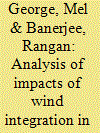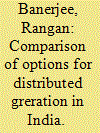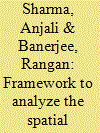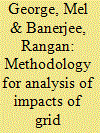| Srl | Item |
| 1 |
ID:
115139


|
|
|
|
|
| Publication |
2012.
|
| Summary/Abstract |
There is a global resurgence in solar thermal power across the world. This paper provides a transparent framework for calculating the cost of generated electricity from a concentrated solar power (CSP) plant and the internal rate of return on equity. The different factors contributing to the capital cost and generation cost of CSP technology have been discussed. The effect of variation of plant size, solar insolation and discount rate has been shown. India has launched the Jawaharlal Nehru National Solar Mission (JNNSM) and plans to install 20 GW of grid connected solar power by 2022. An analysis of the bids received in the National Thermal Power Corporation's Vidyut Vyapar Nigam Ltd. (NVVN) bidding process, indicates that successful companies have access to low interest capital (effective discount rate ranging from 6.3-12.2%). With the current generation cost of 11-12 Rs/kW h (24-25 US Cents/kW h), an achievable target for CSP in the future is likely to be 6.5-7 Rs/kW h (14-15 US Cents/kW h). This may be possible through reductions in solar field and power block costs combined with increases in collector and overall plant efficiency.
|
|
|
|
|
|
|
|
|
|
|
|
|
|
|
|
| 2 |
ID:
090105


|
|
|
|
|
| Publication |
2009.
|
| Summary/Abstract |
As the share of wind in power systems increases, it is important to assess the impact on the grid. This paper combines analysis of load and generation characteristics, generation adequacy and base and peak load variations to assess the future role of wind generation. A simulation of Tamil Nadu in India, with a high penetration of wind power (27% by installed capacity), shows a capacity credit of 22% of the installed wind capacity. For seasonal wind regimes like India, neither the capacity factor, nor the capacity credit reflects the monthly variation in the wind generation. A new approach based on the annual load duration curve has been proposed for generation expansion planning with higher penetration of wind. The potential savings in base and peak capacity required with increasing wind power have been quantified. A future scenario for Tamil Nadu for 2021 has been illustrated. It was found that 5500 MW of wind power can save 3200 MU of peak energy required or an average peak capacity of 2400 and 1100 MW of base capacity. This analysis would be useful to assess the future impacts of increasing wind capacity in grids.
|
|
|
|
|
|
|
|
|
|
|
|
|
|
|
|
| 3 |
ID:
068414


|
|
|
| 4 |
ID:
177415


|
|
|
|
|
| Summary/Abstract |
This paper presents an analytical framework to study the spatial distribution of the labor impacts of clean energy transitions. While there exists optimism about the job creation potential of clean energy industries, just transitions literature has emphasized that the costs and benefits of energy transitions will not be distributed equally. Aggregate labor estimates hide the regional inequalities that might surface sub-nationally.
|
|
|
|
|
|
|
|
|
|
|
|
|
|
|
|
| 5 |
ID:
103386


|
|
|
|
|
| Publication |
2011.
|
| Summary/Abstract |
Present electricity grids are predominantly thermal (coal, gas) and hydro based. Conventional power planning involves hydro-thermal scheduling and merit order dispatch. In the future, modern renewables (hydro, solar and biomass) are likely to have a significant share in the power sector. This paper presents a method to analyse the impacts of renewables in the electricity grid. A load duration curve based approach has been developed. Renewable energy sources have been treated as negative loads to obtain a modified load duration curve from which capacity savings in terms of base and peak load generation can be computed. The methodology is illustrated for solar, wind and biomass power for Tamil Nadu (a state in India). The trade-offs and interaction between renewable sources are analysed. The impacts on capacity savings by varying the wind regime have also been shown. Scenarios for 2021-22 have been constructed to illustrate the methodology proposed. This technique can be useful for power planners for an analysis of renewables in future electricity grids.
|
|
|
|
|
|
|
|
|
|
|
|
|
|
|
|
| 6 |
ID:
128725


|
|
|